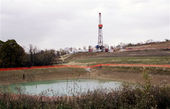In the musical "Urinetown," a severe drought leaves the dwindling supplies of clean water in the hands of a corporation called Urine Good Company. Urine Good Company makes a fortune selling the precious commodity and running public toilets. It pays off politicians to ward off regulation and inspection. It uses the mechanisms of state control to repress an increasingly desperate and impoverished population.

© AP photo / Keith SrakocicA drilling rig used to bore thousands of feet into the earth to extract natural gas from the Marcellus Shale deep underground stands on a hill above a Pennsylvania farm.
The musical satire may turn out to be a prescient vision of the future. Corporations in Colorado, Texas, Louisiana, Pennsylvania and upstate New York have launched a massive program to extract natural gas through a process that could, if it goes wrong, degrade the Delaware River watershed and the fresh water supplies that feed upstate communities, the metropolitan cities of New York, Philadelphia, Camden and Trenton, and many others on its way to the Delaware Bay.
"The potential environmental consequences are extreme," says Fritz Mayer, editor of
The River Reporter in Narrowsburg, N.Y. His paper has been following the drilling in the Upper Delaware River Valley and he told me, "It could ruin the drinking supply for 8 million people in New York City."

Comment: With eight years of global cooling, a quiet sun, recovering and expanding ice extent, increasing the albedo effect of the natural environment may only hasten the cooling.
Mr. Potato Head indeed.